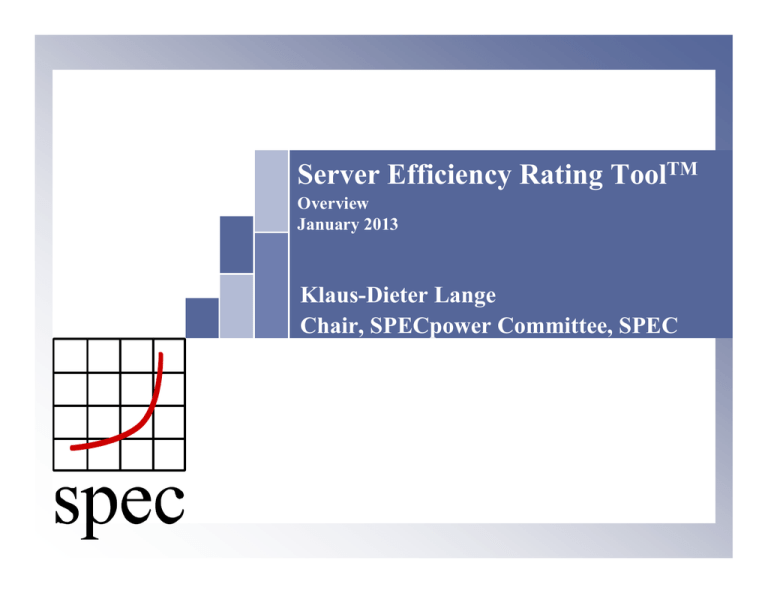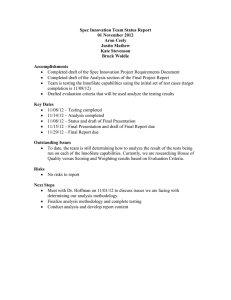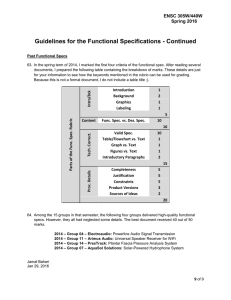
Server Efficiency Rating ToolTM
Overview
January 2013
Klaus-Dieter Lange
Chair, SPECpower Committee, SPEC
SPEC’s Server Efficiency Rating ToolTM
Agenda
SERT Demo/Training Session
SPEC F2F - Austin, TX, USA – 23rd January 2012
SPEC Overview
Worklets
SPEC’s Philosophy
Execution Phases
Milestones
SERT GUI
PTDaemon
SERT Result Report
Goals and Requirements
Efficiency Program Use / Regulations
Taxonomy of Platform Evaluation Tools
SERT Metric/Score
Hardware and Software Configuration
Universal Usage
Workload
Q&A
Copyright © 1988‐2013 Standard Performance Evaluation Corporation (SPEC). All rights reserved.
2
SPEC’s Server Efficiency Rating ToolTM
SPEC Overview
A world-wide non-profit consortium formed in 1988 to establish, maintain
and endorse a standardized set of relevant benchmarks that can be
applied to the newest generation of high-performance computers
Comprised out of over 80 computer hardware and software vendors,
educational institutions and government agencies
Developed over 30 industry-standard benchmarks for system performance
evaluation in a variety of application areas
Largest public repository of well documented, peer reviewed, benchmark
results (~30,000)
In-depth understanding of workloads, benchmark code, fair comparisons
across different platforms
Copyright © 1988‐2013 Standard Performance Evaluation Corporation (SPEC). All rights reserved.
3
SPEC’s Server Efficiency Rating ToolTM
SPEC’s Philosophy
To ensure that the marketplace has a fair and useful set of metrics to
differentiate systems
□ A good benchmark, that is reasonable to utilize, will lead to a greater availability of results
in the marketplace
To provide a standardized suite of code that has already been ported to a
wide variety of platforms
□ The licensee can immediately start with the measurement on all supported platforms
without code-porting
SPEC welcomes organizations to join and participate in our work, and
stands ready to offer guidance on workloads and benchmarks
□ Membership is open to any interested company or entity
Copyright © 1988‐2013 Standard Performance Evaluation Corporation (SPEC). All rights reserved.
4
SPEC’s Server Efficiency Rating ToolTM
Milestones
SPEC Power and Performance Methodology
An introduction on power and performance metrics for computer systems
Guidance for Power and Performance benchmark development (existing and new
designs)
Methodology – captures the experience/conclusions of the SPECpower committee
since January 2006
http://www.spec.org/power_ssj2008/docs/SPECpower-Methodology.pdf
SPEC PTDaemon (Power and Temperature Daemon)
Infrastructure software to connect, control and collect data from power and
temperature measurement devices
http://www.spec.org/power_ssj2008/docs/device-list.html
Copyright © 1988‐2013 Standard Performance Evaluation Corporation (SPEC). All rights reserved.
5
SPEC’s Server Efficiency Rating ToolTM
PTDaemon 1/2
Challenges integrating power analyzers into test tools
Vendor specific, dissimilar programming interfaces and command sets
Diverse result formats
Various connection types (Serial, GPIB, USB) using device specific communication
settings/parameters
Uncertainty calculation missing in vendor control software
PTDaemon accomplishments
Supports multiple protocols and interfaces specific to each device type (Serial, GPIB, USB
etc.)
Supports major global power standards
Defines unified network protocol for device configuration (e.g. range setting) and collecting
power data readings
Remote communication via TCP/IP protocol over LAN
Well defined measurement procedure ensuring comparable power readings
Standardized result format
Acceptance process including examination of device capabilities, adding more devices,
today 14 accepted power analyzers, including multi-channel and 3-phase instruments
Uncertainty calculation
Logging of power readings and problems (errors, warnings)
Copyright © 1988‐2013 Standard Performance Evaluation Corporation (SPEC). All rights reserved.
6
SPEC’s Server Efficiency Rating ToolTM
PTDaemon 2/2
Power Analyzers
Controller
RS232, GPIB, USB connection
command set A
PTDaemon
RS232, GPIB connection
command set B
PTDaemon
RS232, USB connection
command set C
unified
network protocol
SERT director
PTDaemon
Accepted measurement devices: http://www.spec.org/power/docs/SPECpower‐Device_List.html
Copyright © 1988‐2013 Standard Performance Evaluation Corporation (SPEC). All rights reserved.
7
SPEC’s Server Efficiency Rating ToolTM
Goals and Requirements 1/2
Server Efficiency Rating Tool (SERT)
Evaluate the energy efficiency of computer servers
Built for and in conjunction with the US EPA Energy Star Program
□ Collaborate on workload, metric and logistics
First order approximation of server efficiency
□ Executes a variety of common types of work (worklets)
□ Not representative of any particular application area
□ Not a capacity planning tool
Economical, easy to use, minimal equipment and skills requirements
□ Through automated processes
Hardware Architecture and OS Agnostic
□ Supports various hardware platforms and OS’s
Leverage and extend SPEC methods, code-base and expertise
AMD, Dell, Fujitsu, HP, Intel, IBM, Microsoft have committed resources for
the development of SERT in the SPECpower Committee
Copyright © 1988‐2013 Standard Performance Evaluation Corporation (SPEC). All rights reserved.
8
SPEC’s Server Efficiency Rating ToolTM
Goals and Requirements 2/2
Processor sockets/compute nodes
SERT 1.0.0 will be designed for and tested with
□ Max. 8 sockets per node
□ Max. 64 server nodes
□ Limited to homogeneous multi-node and blade servers
DC power measurement
□ No resource committed for development and test
Platform/OS
SERT 1.0.0 will be implemented for and is planned to be tested on the
following platform OS (64-bit only) combinations, pending resources:
Platform
X86
(AMD)
X86
(AMD)
X86
(Intel)
X86
(Intel)
Power
OS
Windows
2008 R2
LINUX
Windows
2008 R2
LINUX
AIX
Copyright © 1988‐2013 Standard Performance Evaluation Corporation (SPEC). All rights reserved.
9
SPEC’s Server Efficiency Rating ToolTM
Taxonomy of Platform Evaluation Tools
Increasing Accuracy, Cost to Use
Orders of
Approximation1
1.
Typical / Desired Attributes
Examples
Generalized Evaluation Tools
Architecture Agnostic
Usually Synthetic
Represents Multiple Environments
Software Selection & Tuning Limited
Consistent, Repeatable Results
Low Cost to Use
Standard Benchmarks
Usage Categories
Architecture Agnostic
Represents Generic App Environment
Software Selection & Tuning Open
Consistent, Repeatable Results
Moderate to High Cost to Use
Server Efficiency
Rating ToolTM
SPECweb2009
SPECpower_ssj2008
SPEC CPU2006
SPECmail2009
TPC-E
…
Application Benchmarks
Usage Specific
Architecture Dependent
Represents Specific Environment
Software Selection & Tuning Limited
Results dependent on builder skills
High Cost to Create and/or Use
SAP R/3 SD
User Created
…
Taxonomy from: “The State of Energy and Performance Benchmarking for Enterprise Servers” ; A. Fanara, E. Haines, A Howard; August 2009
Copyright © 1988‐2013 Standard Performance Evaluation Corporation (SPEC). All rights reserved.
10
SPEC’s Server Efficiency Rating ToolTM
Hardware and Software Configuration
Controller and SUT
Controller
Chauffeur
SPEC PTDaemon
Reporter
SPEC PTDaemon
GUI
System Under Test
Network
Memory
Workload
Workload
Worklet A
Storage
Worklet B
Temperature Sensor
Power Analyzer
Worklet C
PSU
PSU
Copyright © 1988‐2013 Standard Performance Evaluation Corporation (SPEC). All rights reserved.
CPU
CPU
11
SPEC’s Server Efficiency Rating ToolTM
Workload
SERT‘s Workloads (Collections of Synthetic Worklets)
Worklet design guidelines:
□ Worklets to assess CPU, Memory, Storage IO subsystem
□ Network IO will be handled by configuration power/performance modifiers
□ Worklets do not represent a particular application
□ Adjustable to different performance levels
□ Self-calibrate to maximum performance level
□ Multiple programming languages may be used
□ Scale with the available hardware resources
□ Higher worklet score indicates higher energy efficiency
Different worklet scores will have different metrics and can not be compared against
each other
The definition of the worklet scores is currently in development
Copyright © 1988‐2013 Standard Performance Evaluation Corporation (SPEC). All rights reserved.
12
SPEC’s Server Efficiency Rating ToolTM
Worklets
Workload
Load Level
Worklet Name
Compress
CryptoAES
LU
CPU
100%, 75%, 50%, 25%
SHA256
SOR
SORT
XMLValidate
Memory
Flood: Full, Half
Flood
Capacity: 4GB, 8GB, 16GB, 128GB, 256GB, 512GB, 1024GB
Capacity
Random
Storage
100%, 50%
Hybrid
100%, 87.5%, 75%, 62.5%, 50%, 37.5%,25%, 12.5%
SSJ
Idle
idle
Idle
Copyright © 1988‐2013 Standard Performance Evaluation Corporation (SPEC). All rights reserved.
Sequential
13
SPEC’s Server Efficiency Rating ToolTM
Execution Phases
W
30
seq.
S PR Cal. 1 PO S PR Cal. 2 PO S PR 100% PO S PR 75% PO S PR 50% PO S PR 25% PO
10 15 120 15 10 15 120 15 10 15 120 15 10 15 120 15 10 15 120 15 10 15 120 15
meas.
meas.
meas.
meas.
meas.
meas.
interval
interval
interval
interval
interval
interval
sequence
sequence
worklet
W = Warmup (30 sec)
S = Sleep (10 sec)
PR = Pre measurement (15 sec)
PO = Post measurement (15 sec)
Cal. N = Calibration Interval N (120 sec)
nnn% = Measurement Phase (120 Sec)
Total minimum execution time per worklet = 990 sec
plus worklet initialization times
Copyright © 1988‐2013 Standard Performance Evaluation Corporation (SPEC). All rights reserved.
14
SPEC’s Server Efficiency Rating ToolTM
SERT GUI
Graphical interface
□ Gathering SUT hardware and software configuration data
□ Configuring and running the SERT
□ Archiving the measured results and log files.
Provides ability to save and re-import complete configurations to simplify
repeated testing.
Default Mode (EPA compliant test record)
□ Executes the entire SERT suite (all worklets) in sequence, each worklet in a new
instance of the local JVM
Advanced Research Mode
□ Selective execution of a subset of workloads and worklets.
□ Customization of worklet run-times and parameters.
Copyright © 1988‐2013 Standard Performance Evaluation Corporation (SPEC). All rights reserved.
15
SPEC’s Server Efficiency Rating ToolTM
SERT GUI
Host Discovery
Launch Test
Automatically gather detailed hardware and software
configuration of the SUT
Monitor Progress of the currently executing worklet
and the entire suite.
Copyright © 1988‐2013 Standard Performance Evaluation Corporation (SPEC). All rights reserved.
16
SPEC’s Server Efficiency Rating ToolTM
SERT Result Report 1/3
Copyright © 1988‐2013 Standard Performance Evaluation Corporation (SPEC). All rights reserved.
17
SPEC’s Server Efficiency Rating ToolTM
SERT Result Report 2/3
Results Summary Table
Copyright © 1988‐2013 Standard Performance Evaluation Corporation (SPEC). All rights reserved.
18
SPEC’s Server Efficiency Rating ToolTM
SERT Result Report 3/3
SUT Hardware Description
Copyright © 1988‐2013 Standard Performance Evaluation Corporation (SPEC). All rights reserved.
19
SPEC’s Server Efficiency Rating ToolTM
Efficiency Program Use / Regulations
Execution
□ Depending on efficiency program regulations, e.g. Certification Bodies may be required
(qualified labs, currently US only)
□ Acceptable tuning parameters will be defined by processor manufacturers and must be
used for SERT testing
Reporting
□ User must provide a predefined set of information describing the hardware and software
used for this report, partly discovered automatically by SERT
□ Performance and power data, as defined in the SERT result file, must be sent to efficiency
program institutions
□ SERT results will be publicly available from efficiency program institutions,
the format may vary from the original SERT result file, in addition aggregated data formats
may be available
Metrics
□ Will be defined after reporting only phase based on available results,
critical mass of results is necessary
Acceptance criteria for efficiency labels
□ Will be defined by efficiency program institutions
□ Initial criteria without SERT scores, e.g. reporting only
Copyright © 1988‐2013 Standard Performance Evaluation Corporation (SPEC). All rights reserved.
20
SPEC’s Server Efficiency Rating ToolTM
SERT Metric/Score
Configuration power/performance modifier
□ “Substitution” for real measurements for items SERT can not measure or the
performance can not be determined (e.g., redundant power supplies)
□ TBD, based on data collection phase.
Each worklet will produce a measure representing the performance achieved by the
SUT as well as the average power consumption at multiple target load levels. An
overall score(s) is not provided and not recommended.
Complexity of performance and power measures across components at multiple
target load levels makes creation of a metric difficult.
Recommend to implement a 9-12 month reporting-only phase first. At successful
completion, SPEC will recommend a data-driven metric and scoring algorithm.
Metric and Level Phase
Reporting-Only Phase
Data Analysis Phase
Metric and Level Proposal
Copyright © 1988‐2013 Standard Performance Evaluation Corporation (SPEC). All rights reserved.
21
SPEC’s Server Efficiency Rating ToolTM
Universal Usage
SERT is applicable to programs world-wide
SPEC anticipates the use of SERT in many programs
As more programs adopt the use of SERT, the base of data grows
SERT will be an outstanding research tool
Versatile and flexible tool to test different aspects of computer servers at a variety of stress
levels
SERT can be an excellent tool for energy efficiency programs
Breadth of functional coverage allows for broader span of configurations
“Tool” not “Benchmark” allows for broader span of configurations
Near out-of-box tuning provides relevance to consumers
Copyright © 1988‐2013 Standard Performance Evaluation Corporation (SPEC). All rights reserved.
22
SPEC’s Server Efficiency Rating ToolTM
Q&A
sertsupport@spec.org
www.spec.org/sert
Copyright © 1988‐2013 Standard Performance Evaluation Corporation (SPEC). All rights reserved.
23
SPEC’s Server Efficiency Rating ToolTM
Thank you!
Copyright © 1988‐2013 Standard Performance Evaluation Corporation (SPEC). All rights reserved.
24
SPEC’s Server Efficiency Rating ToolTM
Acknowledgements
SPEC would like to acknowledge the people who have contributed to the
design, development, testing and overall success of the SERT.
Development Team
Christian Koopman, David Ott, Greg Darnell, Hansfried Block, Jeremy Arnold,
John Beckett, Karin Wulf, Klaus-Dieter Lange, Mike Tricker, Nathan Totura, Sanjay
Sharma, Karl Huppler, and Van Smith
Development Support
Charles Pogue, David Mulnix, Peter Klassen, Shreeharsha G. Neelakantachar,
and Thomas Brand
Administrative Support
Bob Cramblitt, Cathy Sandifer, Charles McKay, Dianne Rice, Elden Sodowsky,
and Jason Glick
SPEC, the SPEC logo and the tool and names SERT, SPECpower_ssj2008, are registered trademarks of
the Standard Performance Evaluation Corporation (SPEC).
Copyright © 1988‐2013 Standard Performance Evaluation Corporation (SPEC). All rights reserved.
25
SPEC’s Server Efficiency Rating ToolTM
References
Server Efficiency Rating Tool home page
• http://www.spec.org/sert/
Server Efficiency Rating Tool public Design Document:
• http://www.spec.org/sert/docs/SERT-Design_Doc.pdf
ENERGY STAR Enterprise Servers V2 home page
• https://www.energystar.gov/products/specs/node/142
Copyright © 1988‐2013 Standard Performance Evaluation Corporation (SPEC). All rights reserved.
26







